Ron Witton
I recently came across three books that trace, pictorially, the history of the development of Jakarta, from the earliest days of photography in the mid-nineteenth century through to 1980:

Browsing through the books brought back a kaleidoscope of memories.
It all began in early 1962 when, as a newly arrived 18-year-old, first-year student at Sydney University, I sat down in Fisher Library next to an Asian student. We got talking about what we were studying and I told him I was studying French and German. He told me his name was Albert Kwee and that he came from Indonesia. He said that although he was of Chinese descent, he did not speak Chinese as his family had lived in Indonesia for many generations and only spoke Indonesian, the national language. Curious, I asked him about the language. He wrote down a few sentences, showing me that it was written perfectly phonetically in Latin script, had a very simple, straightforward grammar in that its verbs did not conjugate and its nouns and adjectives did not decline. For someone who had struggled through high school with the grammatical idiosyncrasies of Latin, German and French, and the intimidating nature of French pronunciation, Indonesian seemed like a breath of fresh air.
Soon after, I found that Sydney University had a Department of Indonesian and Malayan Studies. I quickly enrolled, and in so doing determined the course of the rest of my life. Albert became a life-long friend, each of us being best man at our respective weddings. I ended up completing my bachelor, master and doctoral degrees in Indonesian studies, have often lectured on Indonesia, and still work as an Indonesian interpreter and translator.
Half way through my first year studies, I was so taken by Indonesian studies that I decided to buy a ticket on a Lloyd Triestino passenger liner to see the country for myself. This is how, in December 1962, I caught my first glimpse of Indonesia from the deck of a ship as it sailed into Tanjung Priok, Jakarta’s harbour. I still have the letters I wrote home to my family and upon reading them now, I am transported back. In the distance behind the city, there were mountains and on the wharf below, I could see Albert’s family holding up a sign saying ‘Kwee’ so that I could recognise them. As they drove me to their home, I was overwhelmed by the stifling heat and humidity, the kaleidoscopic impression of becaks (pedicab), cars, army lorries, buses, street vendors, people, people and people. They drove me to their suburban house on Jalan Mangga Besar Raya in Kota, the north district of the city.
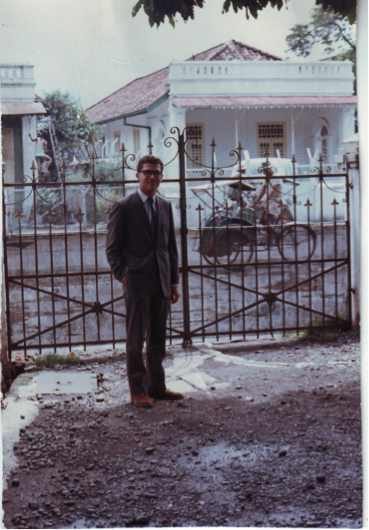
Jalan Mangga Besar Raya was a wonderful introduction to Indonesian urban life. There was the constant ‘tok-tok’ of bamboo sticks and ‘clang-clang’ of metal bells coming from the street as a steady stream of vendors walked, pedaled and rode past the front gate selling a multitude of products, ranging from every conceivable type of food delicacy to every household good one might possibly want. Up the street was Prinsen Park, to which families thronged to enjoy the rides, performances and recreational facilities that had existed since colonial times. At the other end of the street were the major thoroughfares of Jalan Hayam Wuruk and Jalan Gajah Mada, which were then still rather grand tree-lined boulevards.
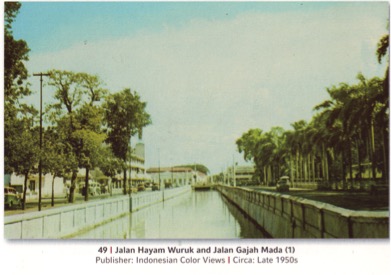
I soon became immersed in the Jakarta of the early sixties. The Kwee family drove me around the city to see the newly built monuments to Sukarno’s vision of a modern Indonesia, Sarinah, Jakarta’s first department store (still under construction), the new Japanese-built Hotel Indonesia, and the new Russian-built Senayan sports complex for the Asian Games with the Gelora Bung Karno stadium.
En route to the south of the city to see the newly established satellite residential district of Kebayoran Baru they drove me over the new Swedish-built Semanggi (meaning ‘Cloverleaf’) Bridge:
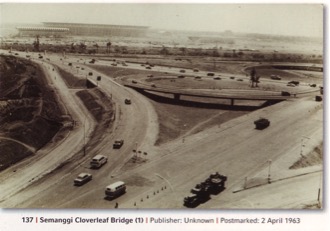
As Scott Merrillees comments in JAKARTA: Portraits of a Capital 1950-1980, ‘In this post card we are looking across a recently completed and still very dusty Semanggi with the new Senayan stadium in the distance.’
I recall that driving south to Kebayoran Baru I could still see rice fields on either side of the road. It is only now that I realise I had a very privileged experience of a world that was soon to change forever. The city has grown from around three million when I arrived in 1962 to the current largely unmanageable population of over 10 million, and continues to grow inexorably. The Kwee’s house on Jalan Mangga Besar Raya is now long gone and the suburban atmosphere I experienced there has been replaced by hotels, nightclubs, brothels and shopping malls. Becaks and many other aspects of 1962 life have disappeared from Jakarta’s streets. I was still able to see many beautiful buildings from the colonial era, such as the charming Hotel des Indes, which had already been renamed Hotel Duta.
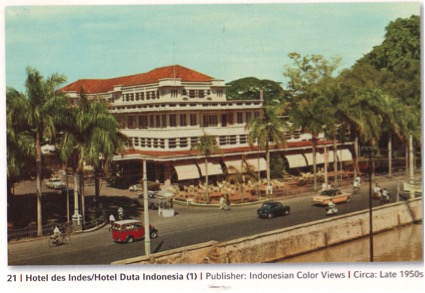
However, the hotel, like many other such historic buildings, was soon to be demolished to make way for a mall. One no longer sees mountains to the south of Jakarta as the pollution has drastically restricted visibility. One can no longer swim on the beach at Cilincing, near Tanjung Priok:
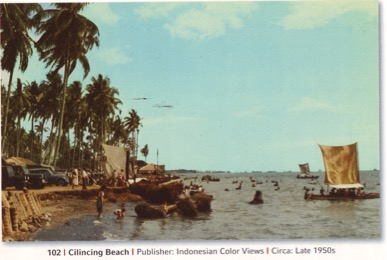
...and the rice fields I saw en route to Kebayoran Baru are also long gone.
I made two more visits to Jakarta in the 1960s, the second in late 1964 when I landed at Kemayoran, Jakarta’s former airport in the city’s east.
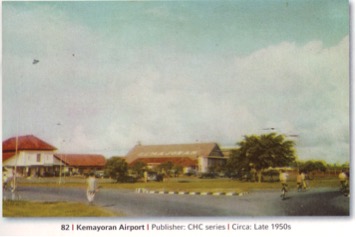
Over the decades since, I have made many more visits. Each time I have seen profound changes to the city, though underneath it all there is the old Jakarta I first experienced in 1962.
The three volumes by Scott Merrillees document, with a multitude of striking photos and postcards, lucidly discussed and contextualised, the way this city has changed from its earliest days as Batavia, Holland’s grand colonial outpost, to Jakarta, the modern city of today. The images accompanying this review are but a small taste of the fascinating sights captured in his three volumes. His commentary on each of the photos and postcards often draws one’s attention to details and features that would otherwise remain unnoticed. He also often links the image to his maps and to other images so that they become in effect a mosaic reflecting the city as a whole.
I am sure that for many who have ever lived in the city, one’s first inclination is to use the excellent indexes and maps in each volume to locate familiar places, relive the experience of having been there at a particular period, and to learn how they have changed over time. For example, I quickly found images of Mangga Besar, in colonial days named Prinsenlaan, and was amazed that the busy, crowded street of my memories had in former times been a quiet, grand tree-lined road:
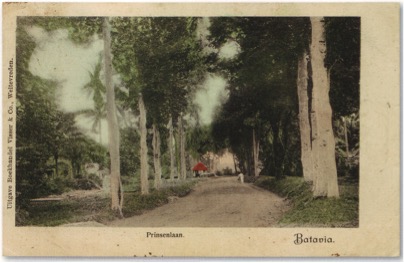
I could even find an image of Prinsen Park, the amusement park down the road from the Kwee family home, whose name commemorates Mangga Besar’s colonial name of Prinsenlaan:
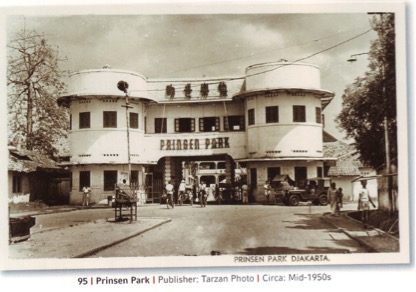
Prinsen Park was then re-named ‘Lokasari’ before finally succumbing to Mangga Besar’s less than family-friendly atmosphere of today. As has been the fate of many a Jakarta landmark, Lokasari was demolished to make way for yet another of Jakarta’s many malls.
The books have allowed me, through its images and maps, to explore where I have lived in later years, including Jalan Raya Radio Dalam in Kebayoran Baru and Jalan Yusuf Adiwinata in Menteng. There is also the enjoyment of looking at the changes in the locations of familiar institutions, such as the Australian Embassy’s former location on Jalan Thamrin before it was moved to Kuningan. I still recall that the embassy, located on the west side of Jalan Thamrin, also had offices on the east side. Due to the heavy and, for those on foot, life-threatening traffic of Jalan Thamrin, embassy regulations required diplomats and staff, if they wanted to go from the main building to the offices across the road, to take an embassy car north on Jalan Thamrin to a roundabout located some distance and then back south so as to enter the building on the east side. To return to the embassy, required a lengthy and often time-consuming trip south to the nearest roundabout. However, it became a badge of courage for some (Australian males, of course) to defy regulations and to cross Thamrin on foot speed. Particular honours were accorded those who managed to do it without stopping en route.
On a recent visit to Cuba I met some Indonesians, now in their eighties, who had been studying in communist countries in 1965 when Indonesia’s military took over Indonesia. The Suharto government forthwith cancelled the citizenship of such students abroad under the assumption they were all communist. Some of the students gravitated to Cuba where they began new lives. One of them told me that in 2000 President Abdurrahman Wahid restored their citizenship and apologised for their enforced exile. One of the exiled students I met in Cuba said that in 2008 he returned to Jakarta for the first time since 1964. He said the Jakarta he encountered was thoroughly bewildering and he could not deal with the large, noisy and overwhelming metropolis. He said he was happy to return to Havana with its old cars, its quiet streets, its clean air and, in his words, its ‘liveability’. He said that he believed that his life in Havana had allowed him to live in a kind of Jakarta frozen in time.
I defy anyone who has ever lived or even visited Jakarta not to lose themselves in memories as they gaze at this treasure of post cards, photographs, maps and images. Indeed, it is the sort of treatment many other major cities of the world deserve.
Scott Merrillees, BATAVIA in Nineteenth Century Photographs (Archipelago Press, 2000); 282 pp: A$ 85 plus postage from scott@bataviabook.net
Scott Merrillees, Greetings from JAKARTA: Postcards of a Capital 1900-1950 (Equinox Publishing, 2012); 248 pp; A$ 50 plus postage from scott@bataviabook.net; or Rp 495,000 plus postage from www.periplus.com
Scott Merrillees, JAKARTA: Portraits of a Capital 1950-1980 (Equinox Publishing, 2015); 159 pp; A$ 50 plus postage from scott@bataviabook.net; or Rp 495,000 plus postage from www.periplus.com
Ron Witton (rwitton44@gmail.com) gained his BA and MA in Indonesian and Malayan Studies from Sydney University, and then his PhD from Cornell. He has lectured in Sociology and Asian Studies in universities in Australia and Indonesia. He still works as an Indonesian interpreter and an Indonesian and Malaysian translator.